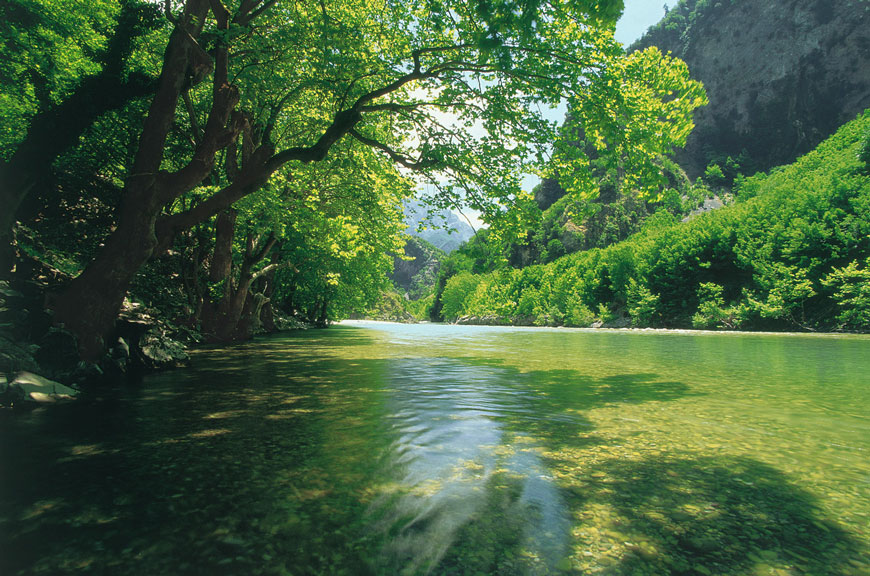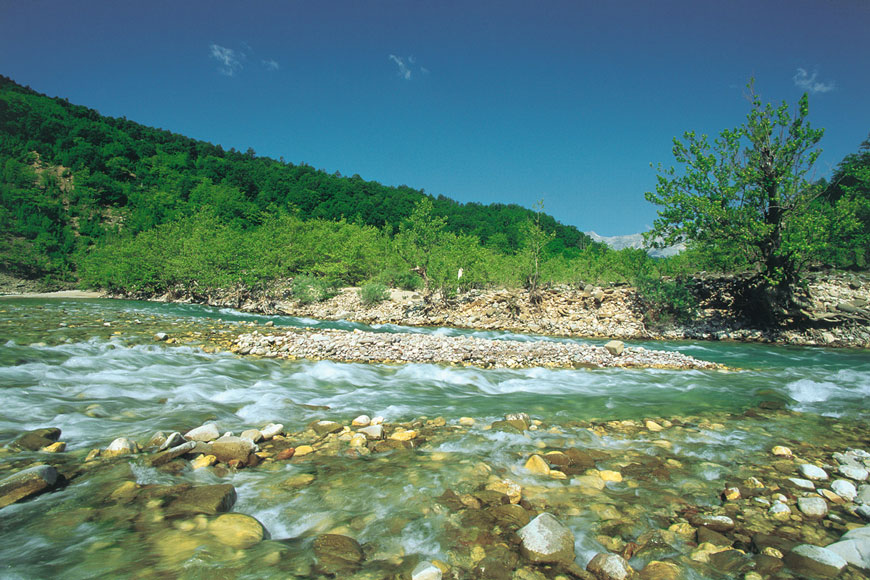
An ancient myth turned into a modern victory for nature
Τετάρτη, 22 Ιανουαρίου 2014

A river god…
Mythology has it that Acheloos was a river-god. Nature has it that Acheloos is an impressive water system, rich in life and beauty.
Acheloos River springs at the heart of the Pindos mountain range. Described by ancient Greek poet Hesiod as “silver-swirling”, the magnificent water system of Acheloos traverses the spine of Western Greece and forms a variety of important habitats, on its way to the Ionian Sea.
The forest and riparian ecosystems of the Southern Pindos, the Acheloos Valley and the delta, are protected under the EU’s habitats and birds directives. At the end of the river, the Messolongi lagoons complex has been designated a national park and one of Greece’s ten sites protected under the Ramsar Convention. The unspoilt middle and upper parts of the river host one of the last remaining habitats for many species of freshwater fish, including the wild trout.
Serious socio-economic and cultural impacts are implicit in the diversion plan, mainly related to the destruction of important cultural monuments (such as the 11th c. monastery of St George of Myrophyllo and a number of stone bridges, which would inundated by the reservoirs) and to the degradation of the already neglected and depopulated area of Southern Pindos.
…fights for life against mighty rivals,
Mythology has it that the lust for a woman caused the fight of Acheloos with a human hero, Hercules, which resulted in the river god losing one of his horns: cornucopia. In contemporary reality, the lust for quick profits is causing the unequal battle of Acheloos with giants: the Greek political elite, the Public Power Corporation and the powerful lobby supporting unsustainable agriculture.
The idea of breaking the horn of fertility from Acheloos, in order to boost agricultural production in the plain Thessaly dates back in the 1930’s, but planning only started in the mid ‘80s. The promise for endless water and productivity to the intensively farmed Thessalian cotton fields was based on another myth: that flowing to the sea is a flaw of nature that needs to be ‘corrected’.
 © N. Petrou
© N. PetrouThe plan initially aimed at the transfer of 1.5 billion m3, which underwent a series of reductions through the years: the plan approved in 1992 would divert 1.2 billion m3 of water, through a tunnel penetrating the mountain. This was later reduced to 600 million m3 and recently dropped further to 250 million m3. Strangely, the dimensions of the tunnel and dams remained unchanged:
- Mesochora major dam (135 m. high) and Mesochora reservoir (358 million m3 volume),
- Mesochora – Glystra tunnel (1 km long),
- Sykia mega dam (150 m. high) and Sykia reservoir (502 million m3 volume),
- Sykia diversion channel to Thessaly (18,500 m. long),
- Mouzaki major dam (initially 135 m. high, later reduced to 55 m.) and reservoir,
- Pyli dam (75 m. high) and reservoir,
- Pyli – Mouzaki tunnel (8 kilometres long).
not a lonely battle!
WWF Greece was never alone in this battle for the river’s life. Since 1992, a dynamic group of major Greek environmental organisations has been actively campaigning against the ecologically perilous and financially unsustainable diversion plan. This campaign, which began as an effort to save the valuable wetlands of the Acheloos estuary, soon became one of the most important and patient environmental campaigns in Europe. The plan is a farewell to reason: another white elephant, walking on an obsolete and unsustainable development model.
Labelled as the “diversion of common sense” the Acheloos scandal repeatedly reached the European Parliament. A massive WWF campaign resulted in 320,000 citizens, primarily from Greece, Germany and Switzerland, voicing their disagreement. The pledges against the project were handed by WWF Greece to the European leaders attending the EU summit in Corfu. This happened in 1994, when Greece held the Presidency of the European Union.
The coalition of environmental groups and local communities from the affected areas was also supported by a few politicians and academics, who marked the campaign by bravely swimming against the current.
 © N. Petrou
© N. PetrouThe campaign of the environmental groups was characterised by a strong legal component. Starting in 1994, a series of battles were won at the supreme administrative court, the Council of State. Despite the court rulings, the diversion plans proceeded, on the basis of renewed approvals.
Twenty years later, a few days after the launch of the 2014 Greek EU Presidency, the mother of all battles was won.
Myth busted: the river god wins battle for life!
Submitted by environmental groups and local municipalities in 2006, the most important ruling was announced in January 2014. In the process of the case, the Greek court submitted to the European Court of Justice 14 questions for preliminary ruling. In the meantime, the suspension of construction works, ruled in 2009 on application by WWF Greece, was a milestone decision that prevented further degradation of the riverine ecosystems, pending the final judgment of the supreme court.
In its decision 24/2014, the Plenary of the Council of State recaps twenty-five years of planning for an ecological, social and financial crime: the diversion plan is not the result of integrated planning, since the amount of water to be transferred keeps changing, cultivation patterns in Thessaly have also changed, whereas it has not been proven that the benefits from the plan outweigh the resulting damage to water ecosystems and prospects for sustainable agricultural development. The plan violates the European Union’s directives on water (2000/60), habitats and species (92/43), environmental impact assessment (85/337) and birds (79/409). Ultimately, the plan violates the principle of sustainable development, which is enshrined in the Treaty of the EU and the Constitution of the Hellenic Republic.
A major victory for nature conservation. A major source of joy and relief for those who fought the good fight on the side of science, transparency and the rule of law, armed with patience and willingness for dialogue.
The major challenge now concerns the rehabilitation of the wounded heart of Acheloos. One of the dams has been constructed since 1997 and still stands empty, whereas the tunnel to Thessaly has been opened and extensive excavation works have taken place at Sykia.
The myth of the river-god’s defeat by the human-hero has been busted. Acheloos is alive and flowing. But, grandiose ideas are hard to land in reality. WWF remains alert to avert any possible revival of the diversion plan.



